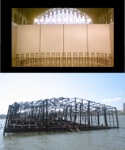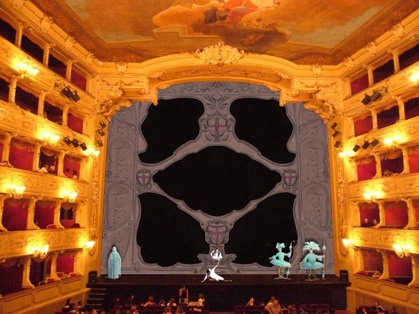VISUAL “SAMENESS” & THE CLOTHES
By writing Romeo for a woman, Bellini creates vocal unity between his two lovers, for Romeo and Giulietta’s vocal lines intertwine to such an extreme that they almost seem to become one. We are especially interested in amplifying Bellini’s decision to write Romeo for a female voice.
Meanwhile, the two warring families are also nearly indistinguishable from one another. The Guelphs and the Ghibellines (the larger factions of the Capuleti and Montecchi families, respectively) were largely divided by territorial conflicts rather than deep ideological differences. People from one side often held mixed loyalties (as Bocca in Dante’s INFERNO), the two sides were nearly identical in physical appearance/dress, and their crests were simply inverse images of one another.
We have worked largely from research of ornate 17th century opera costumes to design exaggerated and two dimensional silhouettes that allow the differences between the principals (in gender, age, family) to be simply and minimally acknowledged, while still allowing for the greater goal of visual sameness between Romeo and Giulietta, and between the Capuleti and Montecchi, to be achieved. For example, we have given Romeo and Giulietta have the same hair and shape of headpieces, and even their “skirts” have the same silhouette, varying only in length to show the difference between men’s and women’s clothing.
THE SPACE
In our work together, Anya and I are always looking for ways to tap into the existing potential of the space, to create an all-inclusive experience for the audience that connects them to the stage by uniting them under one roof, within one event. And as Americans, we rarely have the opportunity to work in such old glorious theatre houses as Como, Pavia, Brescia and Cremona. So we are therefore interested in celebrating the houses themselves. The fancy opulence of these four theatres gives them the feeling of palaces, which serves the story of Romeo and Giulietta well. So we are setting this opera within a palace – Capellio’s palace – where the location is evoked by showcasing and building on the space we are already in.
We use the fresco as an organic element of the theatre itself (each of these theatres already has frescos and/or fresco-like curtains). The plaster of the theatre is replicated in the painted plaster frame of our fresco; and we will use lighting to bring together the color of the plaster in each particular theatre space and the painted plaster frame of our fresco. We also intend to use the existing house lights. The Guelph crests are painted into the fresco to establish that we are in Capellio’s palace. And the medallions within the fresco depict key moments in the history of these two warring families, as if Romeo and Giulietta are inescapably framed by this history, as if it is written into the walls: Capellio raising Capulet troops for battle, Romeo raising the Montecchi, Romeo and Giulietta falling in love, Romeo slaying Capellio’s son, Romeo collapsed at Lorenzo’s feet. During the overture, we will carefully choreograph with light the movement from one medallion to the next, popping each of these fresco panels sequentially to create a kind of two-dimensional, static prologue.
THE PRESENTATIONAL PHYSICALITY AND PERFORMANCE STYLE
The fresco creates a flat shallow playing space, where the staging becomes a series of two-dimensional tableaux, as close to the audience as possible. The singers’ physicality is largely presentational and static, directed out to the audience, and characterized by such stillness that the smallest shifts in focus or posture feel like earthquakes. The flatness of the fresco is only interrupted once at the end when the tomb-like platform with Giulietta in it gets pushed out of the fresco 6’ onto the stage, and Romeo is then able to climb up onto it. Otherwise, the principals are always maximally downstage, frontally oriented and framed by the fresco, with no scenery or props. For Giulietta’s bedroom, Romeo and Giulietta simply stand and sing out; for Romeo’s secret entrance, he simply enters with a heightened physicality of “sneaking in”; for the funeral procession, Romeo and Tebaldo simply look out over the audience.
Anya has specifically drawn each of the five principals with a slightly lifted physicality so as to give a sense of the movement we will work toward in performance. And to further reinforce the presentational nature of the piece we have put all of the principals in 18th century white face.
Just as scenically we do not indicate change in location with added sets or props, so too we more or less remain in one presentational look at all times for the principals. There are only two exceptions: for the wedding party we put the principals and chorus in masks to acknowledge the party and Romeo’s disguise with only a minimal variation in the design. And for the final tomb scene Romeo and Giulietta will strip off their elaborate costumes to end in simple gowns.
THE CHORUS
We have pushed the Coro to a presentational and static extreme in order to emphasize their function as the force (or voice) of inflexible tradition, and to underline the sameness between the Capuleti and Montecchi. We were inspired by some of the statues already in the theatres (e.g. Fraschini di Pavia and Brescia) and cast our Coro as an immobile legion of knight statues ominously looming over the heads of the principals. They are the same color as the plaster of the theatre houses and framing of the fresco. Musically they function more like a force than a community of people, and so we have lifted them up high on a platform behind the fresco. Whenever they “enter”, the upper section of the fresco cleanly splits and lifts to reveal them already lined up there and looming; whenever they “exit”, the upper section lowers and they disappear until the next time the voice of tradition has a say.
Always stationary, the Coro is staged laconically with shifts in weight, posture, focus, spear, etc. Extra members of the Coro will sing from the orchestra pit. Since we do not indicate changes of location with new scenery, props, or clothes, and since we are interested in underlining the sameness between the Capuleti and Montecchi, when we finally see the Montecchi with Romeo in Act Two, there is literally no change – the Coro appears as exactly the same and we only learn who they are by hearing them so named by him. (It is worth noting that in the fresco, the Capuleti and Montecchi are practically identical). The only exception is the party, when the ominous Coro are revealed in identical red and gold masks.
FINALE: THE TOMB
For the final tomb scene, we make the one great shift in design and staging of the production, just as the tone of Bellini’s music becomes significantly darker and less presentational than before. The tomb platform rolls out of the fresco onto the stage for Romeo to climb up onto. He slowly removes his headpiece and knight’s uniform to remain in a simple undergarment. As he does so, the medallions of the fresco slowly black out leaving behind the ghostly skeleton of the fresco frame itself. Romeo opens the tomb upon which he has climbed and pulls out Giulietta’s body —- she is now similarly stripped of her presentational clothes and wears a simple white gown. Upon this tomb, Romeo and Giulietta sing the end of the opera. As Romeo poisons himself and Giulietta dies of grief, the Coro never returns visually, but remains a ghostly voice accompanying the blacked out medallions of the fresco. Only Capellio, Tebaldo and Lorenzo return to the stage, still wearing their exaggerated presentational costumes, to face the tragedy and their guilt.



